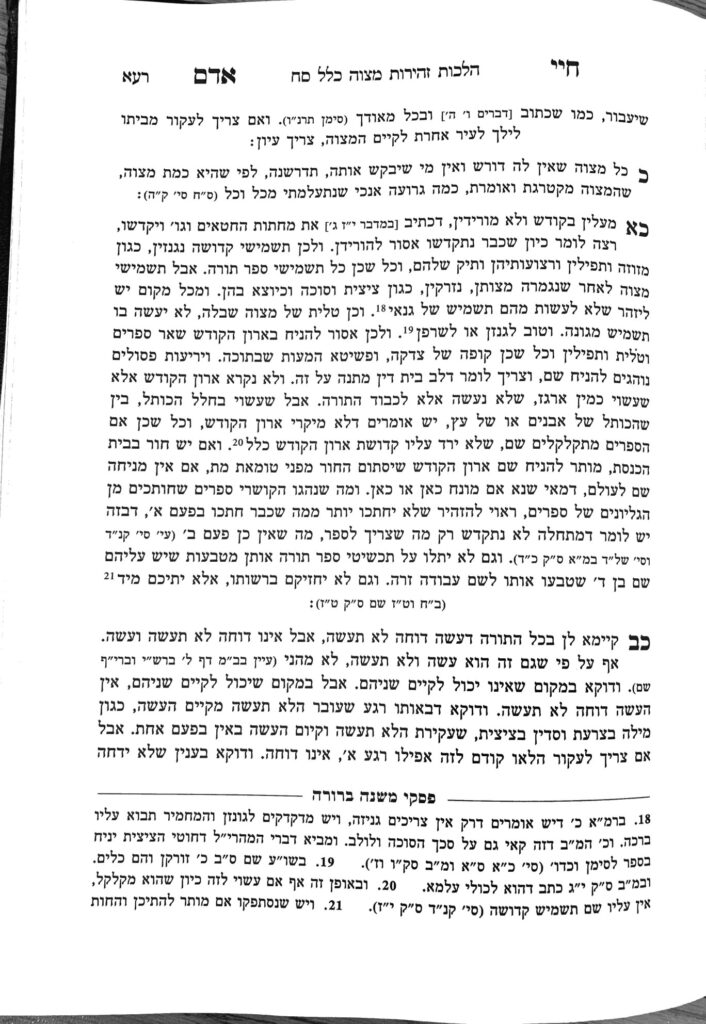We are continuing in siman 21, regarding the concept of ma’alin bakodesh. Today, we will discuss the concept of selling an item of kedusha. This concept is brought in Shulchan Aruch in siman 153, based on a mishnah which discusses a hierarchy of kedusha. The Mishnah in Maseches Megilla, and ensuing Gemara, discuss what can be bought with the proceeds of certain items. The Mishnah says that if the city sells a bais haknesses, they may buy a teiva, which is referring to the bima or aron kodesh. If they sell a teiva, they may use the proceeds to buy a mantel for a Sefer Torah. If they sell a mantel, they may use the proceeds to buy seforim. Seforim refers to a single sefer of chumash written on klaf, or neviim and kesuvim written on klaf. If they sell seforim, they may buy a Sefer Torah. However, they may not sell any of these items for a lower level of kedusha. Even if they use most of the money for a higher level of kedusha, they may not use the leftovers for a lower level of kedusha.
The Mishnah Berurah points out that our (printed) chumashim (even all five chumashim together), which are printed and not handwritten on klaf, obviously do not have the same kedusha as a sefer Torah, but do not even have the kedusha to which the mishnah is referring when it discusses chumashim. However, the Rema in Yoreh Deah writes that they do have the same level of kedusha as neviim on a klaf. Thus, there is certainly a level of kedusha on our seforim, but not as much as something written on klaf.
There are some exceptions. For example, the Shulchan Aruch writes that a Sefer Torah which has a mistake in it does not have the kedusha of a Sefer Torah. We will see more about that.
Another issue that the Shulchan Aruch brings is two opinions regarding whether one Sefer Torah can be sold to purchase another, i.e., buying items of similar kedusha. One did not go down in kedusha (moridin), but did not go up in kedusha (maalin).
The Mishnah Berurah explains that everyone agrees that lechatchila it should not be done, even when we are not concerned that the people will be negligent and not use the money (such as when they sell and buy immediately, etc.). The machlokes is regarding whether bedieved may the money be used to be used to buy another sefer. Certainly, lechatchila it should not be done, but the machlokes is regards what to do once the first Sefer Torah has already been sold. One opinion is that the money may be used to purchase something of equal kedusha, and the other opinion holds it must still be used for a greater level of kedusha, (in the scenario of the sefer Torah, there is no higher level)
It would seem that selling printed seforim to buy other seforim should go into this question as well. Therefore, lechatchila, one may not sell one sefer to buy another. However, the Mishnah Berurah quotes the Taz that nowadays people seem to sell their seforim for the purpose of purchasing others. He explains that we must assume that when a person buys a sefer, it is done with a tenai that they are only purchasing it for as long as they need it, and when they no longer need it, they will be able to sell it. Even if they do not verbalize this tenai explicitly, the tenai works, because, as the Taz explains, we assume that the person never committed to the purchase value of the sefer for longer than the duration of his willful ownership of it.
Summary
- Regarding selling an item of kedusha, the mishnah tells us that an aron kodesh or bimah may be used to purchase the mantel of a Sefer Torah, the mantel may be used to purchase chumashim (single seforim of the Torah; neviim or kesuvim), and chumashim may be used to purchase a Sefer Torah. They may not be used for a lower level of kedusha.
- Exceptions include selling a Sefer Torah with a mistake.
- Selling something for the purpose of buying something of equal kedusha, is not allowed lechatchila. Bedieved, it is a machlokes whether one may buy something of equal kedusha.
- Selling printed seforim for the purpose of buying other printed seforim is accepted because we assume that a tnai was made at the time of purchase.



